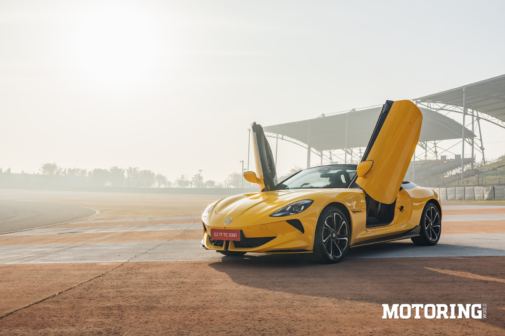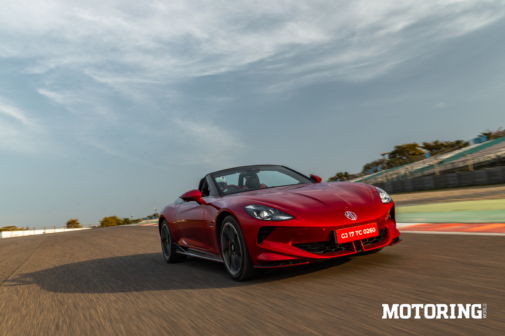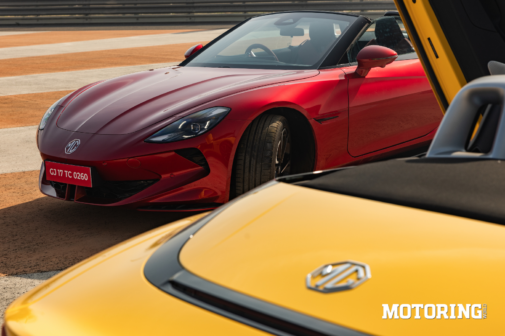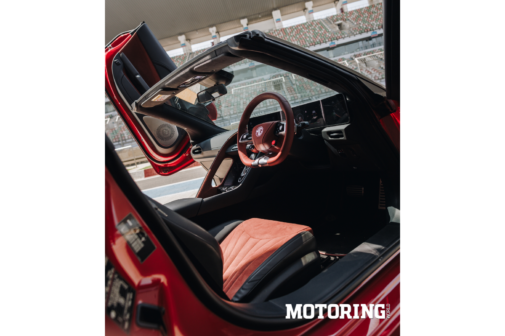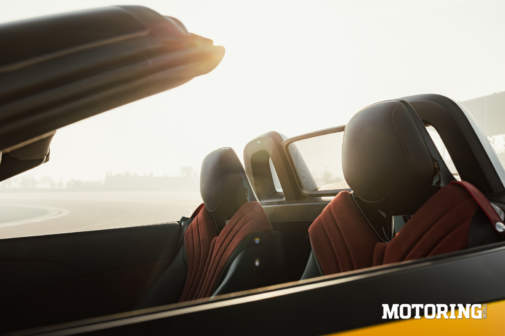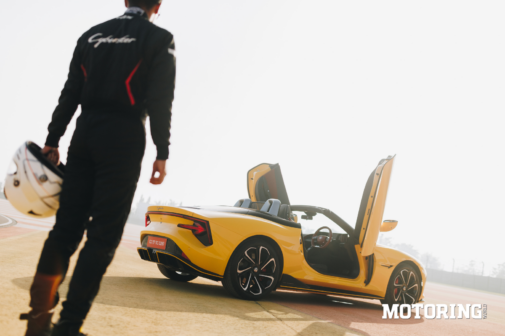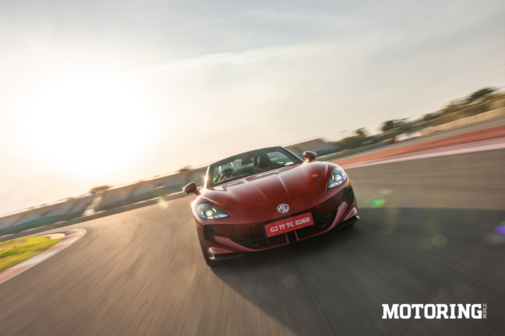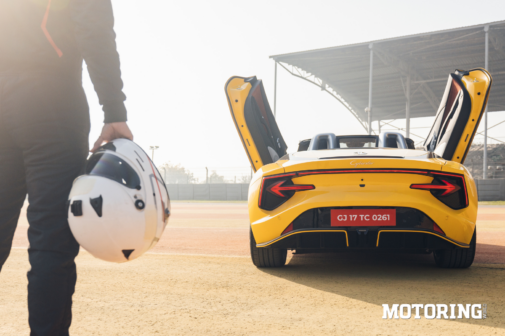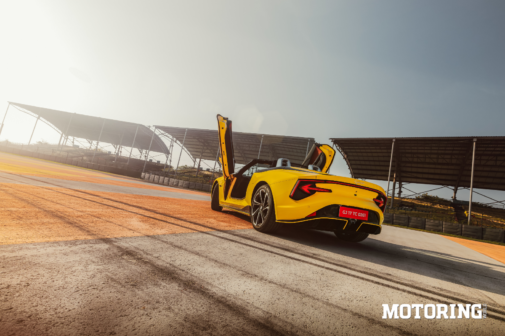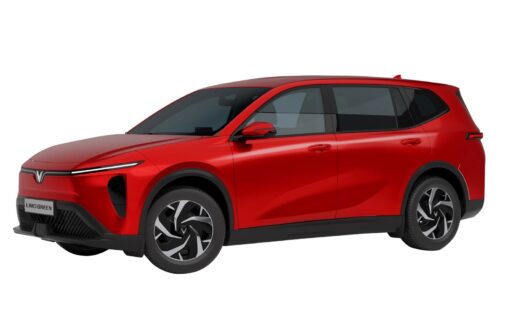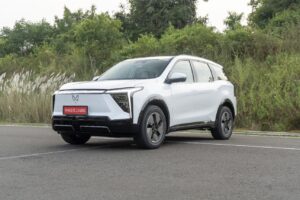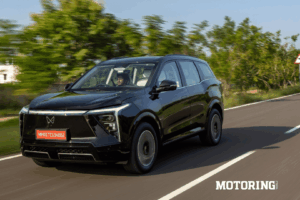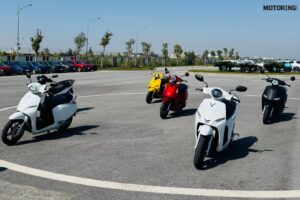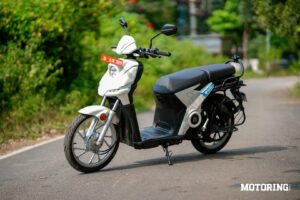Photographs by JSW MG Motor India
Confession time. I don’t really enjoy driving cars around racetracks any more; I’d much rather drive them in real-world conditions, on the nicest possible roads on offer. Given a choice between some laps around a track and a road trip from, say, Goa to Gokarna, I’d pick the latter almost every time. Principally, driving on public roads is a more accurate marker of what that particular car will be like to live with, and driving down a scenic highway beats going round and round a racetrack. Importantly, all that G-force starts to make me queasy; at the MG Cyberster drive at the BIC, halfway through the autocross and slalom courses that had been set up in the parking lot, my stomach had had enough, and I threw in the towel before the possibility of throwing in something far more unpleasant arose.
A little about the Cyberster, then. MG’s electric, scissor-doored roadster, priced at ₹74.99 lakh (ex-showroom), has a 77 kWh battery, and a dual-motor AWD setup, putting out 503 bhp and 74 kgm, both extremely impressive numbers. MG says a 0-100 kph sprint takes 3.2 seconds, and a claimed 580 km range is on offer, which will likely be closer to 400 km with enthusiastic driving. It’s one of two cars sold through MG’s Select dealerships, and it’s a pretty bold effort to revive MG’s storied sportscar legacy, while also firing a few shots at cars like the BMW Z4, and even the Kia EV6. My time with it was short – three laps on the BIC and a round and a half of the autocross/slalom/figure-of-8 course in the parking lot — but it was enough to form initial impressions of this rather tasty-looking EV.
The Cyberster in Flare Red is a proper stunner, no two ways about it. At 4.53 metres long, 1.91 metres wide, and 1.33 metres tall, with a 2.69-metre wheelbase, it’s got the roadster proportions down pat — a long hood, a stubby rear deck. The sculpted nose is sleek, with swept-back LED headlights and active aero vents, and the svelte, recessed derrière has arrow-shaped tail lights that could have gone down the OTT path, but don’t; in fact they look surprisingly good. The scissor doors, which open upward via no fewer than three different buttons in the car and one on the key fob, are guaranteed to draw an instant crowd; they will, however, be a handful in tight, crowded spaces – you’ll have to be careful not to smack someone in the chin with them. The 20-inch dual tone alloys, shod with Pirelli P-Zero rubber, look like they mean business, and the soft-top roof folds in 10 seconds at up to 50 kph. The car’s build quality looks and feels excellent, with tight panels and doors that close with a satisfying thud (though a slight creak from the roof mechanism came through when stowed).
Sliding into the Cyberster’s cockpit was reasonably easy for my 5’11” frame, despite the theatrical doors. The cabin is rather impressive, I have to say – a proper tech-fest, with a tri-screen dashboard: a 10.25-inch driver display, flanked by two 7-inch screens for media and stats, plus a separate climate control screen. I’m not the biggest fan of digital displays, but I must admit that these are very crisp and great to look at. The flat-bottomed steering wheel, packed with controls, feels nice and grippy, and the rust-and-black seats strike a very nice balance between support and comfort, hugging you without squeezing you to death. Other features include a Bose 8-speaker system, a 360-degree camera, wireless Android Auto and Apple CarPlay, wireless phone charging, heated seats (not sure why those are needed here) and connected car tech. There’s 250 litres of boot space on offer, which is par for the course for a drop-top, and there’s space for some small bags behind the seats as well.
The cabin’s not perfect, of course. The touchscreen menus are fiddly, with the climate controls buried frustratingly deep. The plastics around the centre console feel a tad cheap for a ₹75 lakh car, and the driver’s seat, while adjustable, sits a bit high, making you feel perched. The ergos are driver-focussed, no doubt, but they take a little getting used to, especially the screen-heavy layout. It’s a plush space, but I’d want to set out on a long drive to see how the cabin holds up.
The BIC’s back straight was the main stage during my short drive. The Cyberster has launch control, which is activated by selecting Super Sport mode with the big red button on the steering wheel, turning off ESC, holding down the brake pedal with your left foot, giving it the beans and then releasing the brakes. The esultting acceleration was absolutely brutal — 0 -100 kph felt quicker than the claimed 3.2 seconds, pinning me to my seat with a massive, electric surge that was more spaceship than sports car, especially with the whine from the motors. I topped the Cyberster out at 210 kph before hitting the brakes for T4, by which time my kidneys had exchanged positions with my liver, and my torso had just about contained my spine.
Throwing it into T4 immediately brought its 1.9-tonne kerb weight to the fore; at a full 375 kg more than a BMW Z4, a featherweight the Cyberster is not. What it is, however, is friendly and controllable, and that’s important out in the real world. Former F1 engineer Marco Fainello was brought in to tune the chassis, and the brochure for the car throws around words like ‘precision’, ‘reads your mind’ and ‘instinct’. In reality, the Cyberster is more of a boulevard cruiser than a track scalpel; the suspension soaked up the track’s smoother sections, but felt a little floaty in high-speed sweepers, with a hint of body roll. Mid-corner bumps unsettled the chassis slightly, but never disconcertingly, and the Pirelli P Zeros offered reassuring grip; I never felt like the Cyberster would suddenly break loose, at any point. The steering was accurate, with a very consistent weight, but it lacked the tactile feedback of a Porsche or BMW. The Brembo four-piston brakes bit hard, stopping the car from 100 kph in a claimed 33 metres without noticeable nose dive, but the pedal feel was somewhat numb. Honestly, three laps weren’t enough to fully test the car’s limits, but the Cyberster nevertheless felt quick and composed, if not razor-sharp.
The parking lot course — a tight autocross, a slalom and a figure-of-8 — was a different beast. In Sport mode, the Cyberster’s low centre of gravity and 50:50 weight distribution helped it weave through cones with poise. The Pirelli tires gripped well on the dry asphalt, and the AWD system kept things tidy, though the steering’s lack of feel made precise inputs a bit of a task. The slalom highlighted the car’s heft; quick direction changes induced some wallow, and the suspension didn’t settle as fast as I’d have liked. The figure-of-8 was fun, with enough torque to power out of turns, but the ESP kicked in aggressively when I pushed too hard, reining in any tail-happy antics (the other thing that kicked in aggressively was nausea, which led to my abandoning a second attempt at the course). Turning off ESP might have allowed sillier angles, but the course’s tight layout didn’t give me much room to experiment. The Cyberster handled the autocross competently, but it’s no lightweight Lotus Elise; it hustles competently when pushed, but don’t expect it to be an outright ‘driver’s’ car. Through all of the driving, the electric powertrain’s silence was rather eerie, though MG’s synthesized in-cabin buzz added a smidge of character.
After all of 15 minutes with the car, the MG Cyberster left me entertained, but not hopelessly smitten. It’s undoubtedly a showstopper — those scissor doors and the drop-top will make every entry a spectacle, and the 503 bhp delivers supercar-level jollies in a straight line. On the track, it was blisteringly quick, with strong brakes and decent composure, but the soft suspension and numb steering dulled the edge in corners. The autocross course showed that it’s capable in tight spaces, but its weight and lack of steering feel keep it from feeling truly agile. The cabin’s tech-heavy and plush, but clunky menus are a let-down at this price.
In India’s context, the Cyberster is an interesting proposition. At ₹75 lakh, it’s considerably cheaper than a BMW Z4 M 40i (₹92.9 lakh) – but significantly pricier than most expect from MG. Its USP is that no other electric roadster exists here, and its blend of retro-inspired design and outright performance is compelling. It’s more grand tourer than hardcore sports car, and for monied enthusiasts who want a flashy, fast, electric convertible, it’s a tempting choice; purists won’t look past a Porsche Cayman or Boxster, although they’ll have to get a used one at this point. As for me, I enjoyed the Cyberster, but I’d need a proper road trip to see if it’s worth its asking price (you know what to do, MG). For now, ‘the world’s fastest MG’ is a hell of a statement from the brand.
AUTODATA
MG CybersterPOWERTRAIN
Battery:
Max Power:
Max Torque:
Range:
77 kWh
503 bhp
73.92 kgm
580 km
TYRES
F/R: 245/40 R20/275/35 R20
DIMENSIONS
L/W/H (mm):
Wheelbase:
Kerb Weight:
Ground Clearance:
4535/1913/1329
2690 mm
1985 kg
116 mm
PRICE
Rs. 72.50 lakh (ex-showroom)










